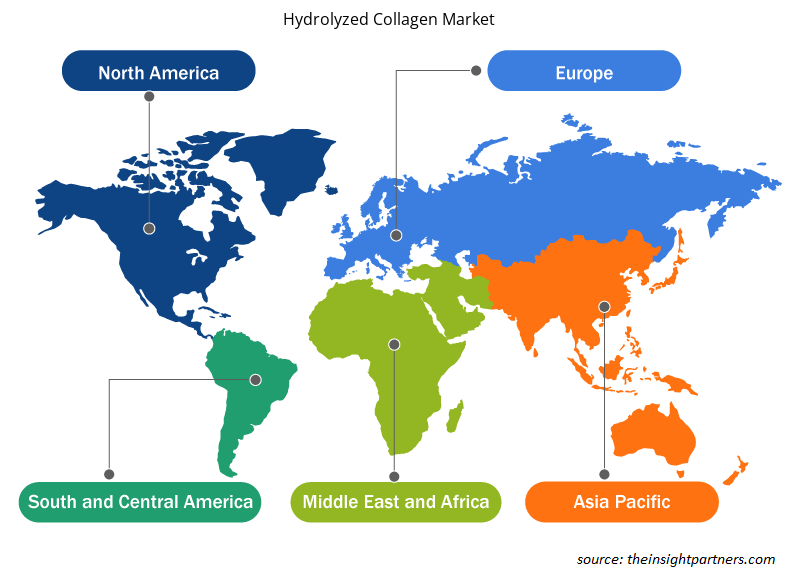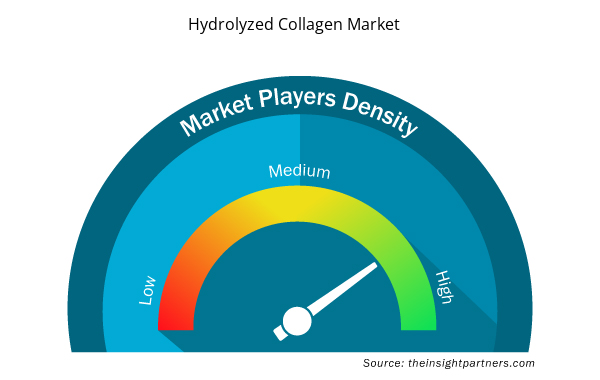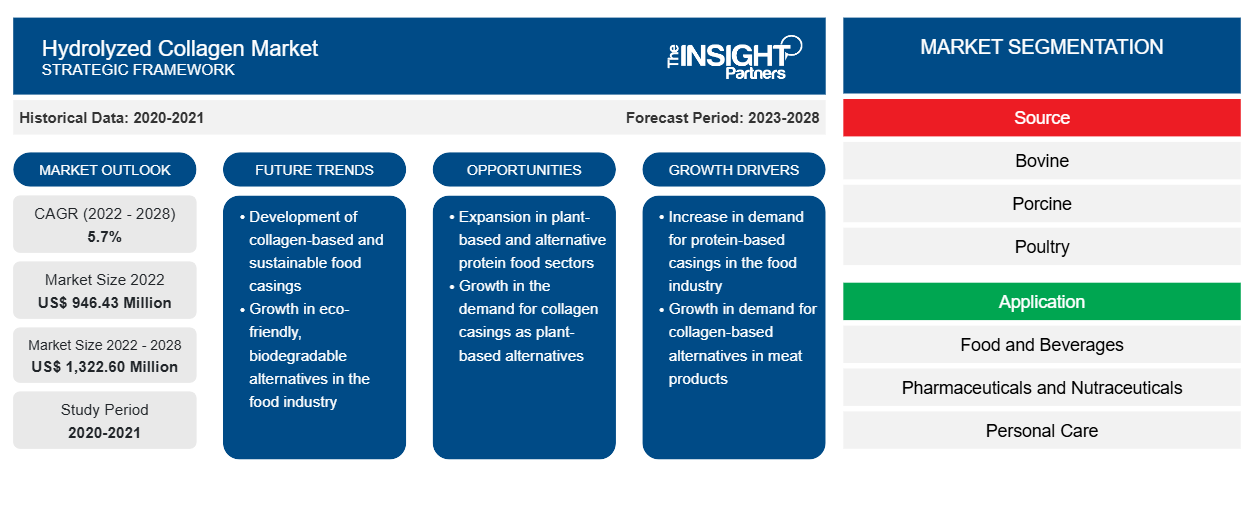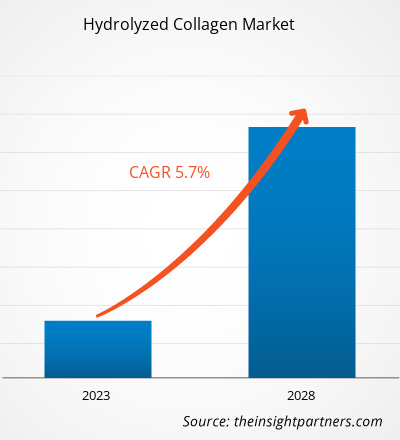[Forschungsbericht] Der Markt für hydrolysiertes Kollagen wurde im Jahr 2022 auf 946,43 Millionen US-Dollar geschätzt und soll bis 2028 1.322,60 Millionen US-Dollar erreichen; von 2022 bis 2028 wird eine durchschnittliche jährliche Wachstumsrate (CAGR) von 5,7 % erwartet.
Hydrolysiertes Kollagen findet bedeutende Anwendung in den Bereichen Biomedizin und Gewebetechnik. Es wird in verschiedenen medizinischen Geräten verwendet, darunter Wundverbände und Füllstoffe für Knochenhohlräume. Hydrolysiertes Kollagen und Gelatine haben eine starke Zellhaftung, Biokompatibilitätseigenschaften und ein hohes Maß an Formbarkeit. Hydrolysiertes Kollagen ist eine wichtige extrazelluläre Matrixkomponente (ECM) in vielen Geweben und Organen. Es spielt eine wichtige Rolle bei der Bildung von Geweben und der Erhaltung der richtigen Gewebearchitektur und -funktion. Daher wurden Zelltransplantationsträger unter Verwendung verschiedener Kollagengerüste wie Schwämme und Gele entwickelt. Die wachsende Nachfrage nach hydrolysiertem Kollagen für verschiedene Anwendungen treibt also das Marktwachstum voran.
Im Jahr 2022 hatte Nordamerika den größten Anteil am globalen Markt für hydrolysiertes Kollagen , und der asiatisch-pazifische Raum wird im Prognosezeitraum voraussichtlich die höchste durchschnittliche jährliche Wachstumsrate verzeichnen. Funktionelle Lebensmittel und Getränke mit hydrolysiertem Kollagen spielen eine entscheidende Rolle bei der Stärkung der Haut und verleihen ihr Elastizität und Feuchtigkeit. Sie tragen auch dazu bei, die Integrität des Knorpels zu erhalten, der die Gelenke schützt. Daher haben die mit der Einnahme von hydrolysiertem Kollagen verbundenen Vorteile in Verbindung mit veränderten Vorlieben und Verhaltensweisen der Verbraucher die Nachfrage nach Nutrazeutika auf Basis von hydrolysiertem Kollagen in der gesamten Region angekurbelt. Infolgedessen konzentrieren sich viele große Akteure im Sektor der Nährstoffzutaten auf Expansion und verfolgen zunehmend strategische Planungen. So übernahm die Gelita AG im Dezember 2020 den türkischen Gelatineproduzenten SelJel. Durch dieses Joint Venture würde die Gelita AG ihre Position auf dem Markt für hydrolysiertes Kollagen stärken. Daher hat die zunehmende Umsetzung strategischer Initiativen durch die wichtigsten Akteure das Wachstum des Marktes für hydrolysiertes Kollagen weiter gestärkt.
Passen Sie diesen Bericht Ihren Anforderungen an
Sie erhalten kostenlos individuelle Anpassungen an jedem Bericht, einschließlich Teilen dieses Berichts oder einer Analyse auf Länderebene, eines Excel-Datenpakets sowie tolle Angebote und Rabatte für Start-ups und Universitäten.
- Holen Sie sich die wichtigsten Markttrends aus diesem Bericht.Dieses KOSTENLOSE Beispiel umfasst eine Datenanalyse von Markttrends bis hin zu Schätzungen und Prognosen.
Auswirkungen der COVID-19-Pandemie auf den Markt für hydrolysiertes Kollagen
Die COVID-19-Pandemie hat die Wirtschaft und Industrie in mehreren Ländern auf der ganzen Welt beeinflusst. Lockdowns, Reisebeschränkungen und Betriebsschließungen in Nordamerika, Europa, Asien-Pazifik (APAC), Süd- und Mittelamerika (SAM) sowie dem Nahen Osten und Afrika (MEA) behinderten das Wachstum mehrerer Branchen, darunter die Lebensmittel- und Getränkeindustrie, die Pharma- und Nutraceutikaindustrie sowie die Körperpflegeindustrie. Die Schließung von Produktionseinheiten störte globale Lieferketten, Fertigungsaktivitäten, Lieferpläne sowie den Verkauf lebenswichtiger und nicht lebenswichtiger Produkte. Verschiedene Unternehmen erlebten im Jahr 2020 Verzögerungen bei Produktlieferungen und einen Einbruch der Verkäufe ihrer Produkte. Darüber hinaus zwangen die von den Regierungen verschiedener Länder in Europa, Asien-Pazifik und Nordamerika verhängten Verbote für internationale Reisen die Unternehmen dazu, ihre Kooperations- und Partnerschaftspläne vorübergehend einzustellen. All diese Faktoren behinderten verschiedene Branchen im Jahr 2020 und Anfang 2021 und bremsten damit das Wachstum verschiedener Märkte, darunter des Marktes für hydrolysiertes Kollagen.
Markteinblicke
Strategische Entwicklungsinitiativen wichtiger Marktteilnehmer treiben den Markt für hydrolysiertes Kollagen voran
Hersteller von hydrolysiertem Kollagen weltweit investieren erheblich in strategische Entwicklungsinitiativen wie Produktinnovation, Fusionen und Übernahmen sowie die Expansion ihrer Geschäfte, um viele Verbraucher anzuziehen und ihre Marktposition zu stärken. Sie investieren zunehmend in Produktinnovation, um ihren Kundenstamm zu erweitern und aufkommende Verbrauchertrends zu erfüllen. So brachte beispielsweise die in Australien ansässige Schönheitsmarke „Vida Glow“ im März 2022 natürliche Strahlenkapseln aus Meereskollagen auf den Markt , die aus hydrolysiertem Kollagenpeptidpulver aus nachhaltig gewonnener Fischhaut gewonnen werden. Aufgrund der steigenden Nachfrage kündigte Vida Glow im selben Monat außerdem eine Expansion auf dem US-Markt an. Darüber hinaus wird hydrolysiertes Kollagen heute zunehmend von Herstellern von Tiernahrung verwendet, um die Qualität von Tiernahrung durch Nährstoffanreicherung zu verbessern. So brachte der in Großbritannien ansässige Hersteller Pawable im November 2022 „Collar-Gen“ auf den Markt, ein Nahrungsergänzungsmittel in Pulverform zur Vorbeugung von Gelenk-, Haut- und Verdauungsproblemen bei Hunden. Es enthält fünf verschiedene Arten von 100 % natürlichem hydrolysiertem Kollagen. Solche Produktinnovationen tragen dazu bei, die Reichweite von hydrolysiertem Kollagen zu vergrößern und einen Wettbewerbsvorteil auf den internationalen Märkten zu erlangen, was das Wachstum des Marktes für hydrolysiertes Kollagen weiter vorantreibt.
Quellenbasierte Erkenntnisse
Basierend auf der Quelle ist der Markt für hydrolysiertes Kollagen in Rinder-, Schweine-, Geflügel-, Meeres- und andere Produkte unterteilt. Das Rindersegment hatte 2022 den größten Marktanteil. Nachdem das Kollagen in einer wässrigen Lösung extrahiert wurde, wird es getrocknet und pulverisiert, um ein Endprodukt zu bilden. Es wurde festgestellt, dass Rinderkollagen die Kollagenwerte Typ I und III im menschlichen Körper verbessert. Die Haut besteht hauptsächlich aus Kollagen Typ I und III ; daher hilft die Einnahme in bestimmten Mengen, Falten zu reduzieren, die Elastizität zu fördern und die Hautfeuchtigkeit zu erhöhen. Darüber hinaus zeigte hydrolysiertes Kollagen aus Rinderlungen entzündungshemmende und antioxidative Eigenschaften. Diese Faktoren treiben den Markt für das Segment an.
Anwendungsbasierte Erkenntnisse
Basierend auf der Anwendung ist der Markt für hydrolysiertes Kollagen in Lebensmittel und Getränke, Pharmazeutika und Nutraceutika , Körperpflege und andere unterteilt. Das Segment Lebensmittel und Getränke wird im Prognosezeitraum voraussichtlich die höchste durchschnittliche jährliche Wachstumsrate verzeichnen. Hydrolysiertes Kollagen dient als Bindemittel für Zutaten in Nährstoffriegeln und verbessert deren Weichheit. Aufgrund des gestiegenen Gesundheitsbewusstseins bevorzugen Lebensmittelhersteller hydrolysiertes Kollagen zur Entwicklung nahrhafter Lebensmittelprodukte. Kollagenhydrolysate können Calciumionen binden und so ihre Bioverfügbarkeit verbessern. Daher kann hydrolysiertes Kollagen in funktionellen Lebensmittelzutaten verwendet werden, um Mineralstoffmängel zu beheben.
Hydrolysiertes Kollagen kann für Lebensmittel nützlich sein, die bei kalten oder eisigen Temperaturen gelagert werden müssen, da es als Antikoagulans wirkt und dabei hilft, Zell- und Gewebeschäden zu verringern. Hydrolysiertes Kollagen hilft, die sensorischen, physikalischen und chemischen Eigenschaften des Produkts zu verbessern und aufrechtzuerhalten. Aufgrund der oben genannten Eigenschaften wird hydrolysiertes Kollagen zur Herstellung verschiedener Produkte wie Fleisch, Getränke und Suppen verwendet.
Die wichtigsten Akteure auf dem Markt für hydrolysiertes Kollagen sind Ewald-Gelatine GmbH, GELITA AG, Rousselot BV, Nitta Gelatin Inc, Protein SA, ConnOils LLC, Norland Products Inc, Tessenderlo Group NV, Titan Biotech Ltd und Viscofan DE GmbH. Diese Unternehmen konzentrieren sich auf die Einführung neuer Produkte und geografische Expansionen, um die weltweit wachsende Verbrauchernachfrage zu erfüllen und ihre Produktpalette in Spezialportfolios zu erweitern. Sie verfügen über eine weitreichende globale Präsenz, die es ihnen ermöglicht, einen großen Kundenstamm zu bedienen und so ihren Marktanteil zu steigern.
Regionale Einblicke in den Markt für hydrolysiertes Kollagen
Die regionalen Trends und Faktoren, die den Markt für hydrolysiertes Kollagen im gesamten Prognosezeitraum beeinflussen, wurden von den Analysten von Insight Partners ausführlich erläutert. In diesem Abschnitt werden auch die Marktsegmente und die Geografie für hydrolysiertes Kollagen in Nordamerika, Europa, im asiatisch-pazifischen Raum, im Nahen Osten und Afrika sowie in Süd- und Mittelamerika erörtert.

- Erhalten Sie regionale Daten zum Markt für hydrolysiertes Kollagen
Umfang des Marktberichts zu hydrolysiertem Kollagen
| Berichtsattribut | Details |
|---|---|
| Marktgröße im Jahr 2022 | 946,43 Millionen US-Dollar |
| Marktgröße bis 2028 | 1.322,60 Millionen US-Dollar |
| Globale CAGR (2022 - 2028) | 5,7 % |
| Historische Daten | 2020-2021 |
| Prognosezeitraum | 2023–2028 |
| Abgedeckte Segmente | Nach Quelle
|
| Abgedeckte Regionen und Länder | Nordamerika
|
| Marktführer und wichtige Unternehmensprofile |
|
Dichte der Marktteilnehmer für hydrolysiertes Kollagen: Verständnis ihrer Auswirkungen auf die Geschäftsdynamik
Der Markt für hydrolysiertes Kollagen wächst rasant, angetrieben durch die steigende Nachfrage der Endverbraucher aufgrund von Faktoren wie sich entwickelnden Verbraucherpräferenzen, technologischen Fortschritten und einem größeren Bewusstsein für die Vorteile des Produkts. Mit steigender Nachfrage erweitern Unternehmen ihr Angebot, entwickeln Innovationen, um die Bedürfnisse der Verbraucher zu erfüllen, und nutzen neue Trends, was das Marktwachstum weiter ankurbelt.
Die Marktteilnehmerdichte bezieht sich auf die Verteilung der Firmen oder Unternehmen, die in einem bestimmten Markt oder einer bestimmten Branche tätig sind. Sie gibt an, wie viele Wettbewerber (Marktteilnehmer) in einem bestimmten Marktraum im Verhältnis zu seiner Größe oder seinem gesamten Marktwert präsent sind.
Die wichtigsten auf dem Markt für hydrolysiertes Kollagen tätigen Unternehmen sind:
- Ewald-Gelatine GmbH
- GELITA AG
- Rousselot BV
- Nitta Gelatin Inc.
- Protein-SA
Haftungsausschluss : Die oben aufgeführten Unternehmen sind nicht in einer bestimmten Reihenfolge aufgeführt.

- Überblick über die wichtigsten Akteure auf dem Markt für hydrolysiertes Kollagen
Bericht-Spotlights
- Fortschrittliche Branchentrends auf dem Markt für hydrolysiertes Kollagen unterstützen Unternehmen bei der Entwicklung wirksamer langfristiger Strategien
- Von den Marktteilnehmern in Industrie- und Entwicklungsländern verfolgte Strategien für Unternehmenswachstum
- Quantitative Analyse des Marktes von 2022 bis 2028
- Schätzung der weltweiten Nachfrage nach hydrolysiertem Kollagen
- Porters Fünf-Kräfte-Analyse zur Veranschaulichung der Wirksamkeit von Käufern und Lieferanten auf dem Markt für hydrolysiertes Kollagen
- Aktuelle Entwicklungen zum Verständnis des wettbewerbsorientierten Marktszenarios
- Markttrends und -aussichten sowie Wachstumstreiber und -hemmnisse auf dem Markt für hydrolysiertes Kollagen
- Unterstützung im Entscheidungsprozess durch Aufzeigen von Marktstrategien, die das kommerzielle Interesse untermauern
- Größe des Marktes für hydrolysiertes Kollagen an verschiedenen Knotenpunkten
- Ein detaillierter Überblick und die Dynamik der hydrolysierten Kollagenindustrie
- Größe des Marktes für hydrolysiertes Kollagen in verschiedenen Regionen mit vielversprechenden Wachstumschancen
- Historische Analyse (2 Jahre), Basisjahr, Prognose (7 Jahre) mit CAGR
- PEST- und SWOT-Analyse
- Marktgröße Wert/Volumen – Global, Regional, Land
- Branche und Wettbewerbsumfeld
- Excel-Datensatz


- Adaptive Traffic Control System Market
- Unit Heater Market
- Small Molecule Drug Discovery Market
- Hot Melt Adhesives Market
- Nuclear Waste Management System Market
- Artificial Intelligence in Healthcare Diagnosis Market
- Saudi Arabia Drywall Panels Market
- Hair Extensions Market
- Railway Braking System Market
- Antibiotics Market

Report Coverage
Revenue forecast, Company Analysis, Industry landscape, Growth factors, and Trends

Segment Covered
This text is related
to segments covered.

Regional Scope
North America, Europe, Asia Pacific, Middle East & Africa, South & Central America

Country Scope
This text is related
to country scope.
Häufig gestellte Fragen
The major players operating in the global hydrolyzed collagen market are Ewald-Gelatine GmbH, GELITA AG, Rousselot BV, Nitta Gelatin Inc, Protein SA, ConnOils LLC, Norland Products Inc, Tessenderlo Group NV, Titan Biotech Ltd, and Viscofan DE GmbH
Surging Demand for marine-sourced hydrolyzed collagen to provide potential market opportunities in the coming years for the hydrolyzed collagen. Marine organisms such as fish, jellyfish, sponges, and other invertebrates harbor a significant source of hydrolyzed collagen. They are highly advantageous over other sources, as they are metabolically compatible, lack religious constraints, and are free of animal pathogens. Marine-sourced hydrolyzed collagen is majorly used for skincare product manufacturing. It is a versatile compound capable of healing skin injuries of varying severity and delaying the natural human aging process. Moreover, marine-sourced hydrolyzed collagen can be used as a biomaterial owing to its water solubility and metabolic compatibility. Thus, the demand for marine-sourced hydrolyzed collagen is increasing with its rising utilization for different industrial applications.
Based on source, bovine segments mainly have the largest revenue share. Bovine hydrolyzed collagen supplements may help counter the effects of low collagen levels. Boiling cow bones or other cattle byproducts in water produces this collagen type. After the collagen is extracted in an aqueous solution, it is dried and powdered to form a final product. Bovine collagen has been found to improve Type I and III collagen levels in the human body. The skin is primarily built up of Types I and III collagen; thus, its intake in specified quantities helps reduce wrinkles, promote elasticity, and increase skin moisture. Moreover, hydrolyzed collagen from bovine lungs showed anti-inflammatory and antioxidant properties. These factors are driving the market for the segment.
Strategic development initiatives by key market players are driving the hydrolyzed collagen market. Various end-use industries are adopting business expansion strategies and scaling production capacity to provide better customer satisfaction. For instance, in July 2020, Rousselot and Giusto Faravelli announced a distribution partnership in Italy, effective from October 2020. Under this partnership, Faravelli distributes food and pharmaceutical gelatins, hydrolyzed collagens, and biomedical gelatins across Italy. Thus, expanding businesses to other regions or countries to cater to the increasing demand by consumers drives the market growth. Such development strategies by hydrolyzed collagen manufacturers extend their reach and gain a competitive edge in international markets.
North America accounted for the largest share of the global hydrolyzed collagen market. Functional foods and beverages containing hydrolyzed collagen play a pivotal role in strengthening skin and providing elasticity and hydration to the skin. They also help retain the integrity of cartilage that protects joints. Therefore, benefits associated with the hydrolyzed collagen intake, coupled with changing consumer preferences and behavior, have fueled the demand for hydrolyzed collagen-based nutraceuticals across the region. As a result, many major players in the nutritional ingredients sector are focusing on expansion and increasingly adopting strategic planning.
Based on the application, food and beverages segment is projected to grow at the fastest CAGR over the forecast period. Hydrolyzed collagen is used in various food and beverages such as dairy products, confectioneries, and beverages. It improves the chewiness, foam stabilization, and texture of confectioneries. Additionally, in dairy products, it is used as a texturization and stabilization agent. Hydrolyzed collagen acts as a binding agent for ingredients used in nutritional bars, enhancing their softness. As a result of increased health consciousness, food manufacturers prefer hydrolyzed collagen to develop nutritious food products. Collagen hydrolysates can attach calcium ions, improving their bioavailability. Thus, hydrolyzed collagen can be used in functional food ingredients to manage mineral deficiencies.
Trends and growth analysis reports related to Consumer Goods : READ MORE..
The List of Companies - Hydrolyzed Collagen Market
- Ewald-Gelatine GmbH
- GELITA AG
- Rousselot BV
- Nitta Gelatin Inc.
- Protein SA
- ConnOils LLC
- Norland Products Inc.
- Tessenderlo Group NV
- Titan Biotech Ltd.
- Viscofan DE GmbH
The Insight Partners performs research in 4 major stages: Data Collection & Secondary Research, Primary Research, Data Analysis and Data Triangulation & Final Review.
- Data Collection and Secondary Research:
As a market research and consulting firm operating from a decade, we have published and advised several client across the globe. First step for any study will start with an assessment of currently available data and insights from existing reports. Further, historical and current market information is collected from Investor Presentations, Annual Reports, SEC Filings, etc., and other information related to company’s performance and market positioning are gathered from Paid Databases (Factiva, Hoovers, and Reuters) and various other publications available in public domain.
Several associations trade associates, technical forums, institutes, societies and organization are accessed to gain technical as well as market related insights through their publications such as research papers, blogs and press releases related to the studies are referred to get cues about the market. Further, white papers, journals, magazines, and other news articles published in last 3 years are scrutinized and analyzed to understand the current market trends.
- Primary Research:
The primarily interview analysis comprise of data obtained from industry participants interview and answers to survey questions gathered by in-house primary team.
For primary research, interviews are conducted with industry experts/CEOs/Marketing Managers/VPs/Subject Matter Experts from both demand and supply side to get a 360-degree view of the market. The primary team conducts several interviews based on the complexity of the markets to understand the various market trends and dynamics which makes research more credible and precise.
A typical research interview fulfils the following functions:
- Provides first-hand information on the market size, market trends, growth trends, competitive landscape, and outlook
- Validates and strengthens in-house secondary research findings
- Develops the analysis team’s expertise and market understanding
Primary research involves email interactions and telephone interviews for each market, category, segment, and sub-segment across geographies. The participants who typically take part in such a process include, but are not limited to:
- Industry participants: VPs, business development managers, market intelligence managers and national sales managers
- Outside experts: Valuation experts, research analysts and key opinion leaders specializing in the electronics and semiconductor industry.
Below is the breakup of our primary respondents by company, designation, and region:

Once we receive the confirmation from primary research sources or primary respondents, we finalize the base year market estimation and forecast the data as per the macroeconomic and microeconomic factors assessed during data collection.
- Data Analysis:
Once data is validated through both secondary as well as primary respondents, we finalize the market estimations by hypothesis formulation and factor analysis at regional and country level.
- Macro-Economic Factor Analysis:
We analyse macroeconomic indicators such the gross domestic product (GDP), increase in the demand for goods and services across industries, technological advancement, regional economic growth, governmental policies, the influence of COVID-19, PEST analysis, and other aspects. This analysis aids in setting benchmarks for various nations/regions and approximating market splits. Additionally, the general trend of the aforementioned components aid in determining the market's development possibilities.
- Country Level Data:
Various factors that are especially aligned to the country are taken into account to determine the market size for a certain area and country, including the presence of vendors, such as headquarters and offices, the country's GDP, demand patterns, and industry growth. To comprehend the market dynamics for the nation, a number of growth variables, inhibitors, application areas, and current market trends are researched. The aforementioned elements aid in determining the country's overall market's growth potential.
- Company Profile:
The “Table of Contents” is formulated by listing and analyzing more than 25 - 30 companies operating in the market ecosystem across geographies. However, we profile only 10 companies as a standard practice in our syndicate reports. These 10 companies comprise leading, emerging, and regional players. Nonetheless, our analysis is not restricted to the 10 listed companies, we also analyze other companies present in the market to develop a holistic view and understand the prevailing trends. The “Company Profiles” section in the report covers key facts, business description, products & services, financial information, SWOT analysis, and key developments. The financial information presented is extracted from the annual reports and official documents of the publicly listed companies. Upon collecting the information for the sections of respective companies, we verify them via various primary sources and then compile the data in respective company profiles. The company level information helps us in deriving the base number as well as in forecasting the market size.
- Developing Base Number:
Aggregation of sales statistics (2020-2022) and macro-economic factor, and other secondary and primary research insights are utilized to arrive at base number and related market shares for 2022. The data gaps are identified in this step and relevant market data is analyzed, collected from paid primary interviews or databases. On finalizing the base year market size, forecasts are developed on the basis of macro-economic, industry and market growth factors and company level analysis.
- Data Triangulation and Final Review:
The market findings and base year market size calculations are validated from supply as well as demand side. Demand side validations are based on macro-economic factor analysis and benchmarks for respective regions and countries. In case of supply side validations, revenues of major companies are estimated (in case not available) based on industry benchmark, approximate number of employees, product portfolio, and primary interviews revenues are gathered. Further revenue from target product/service segment is assessed to avoid overshooting of market statistics. In case of heavy deviations between supply and demand side values, all thes steps are repeated to achieve synchronization.
We follow an iterative model, wherein we share our research findings with Subject Matter Experts (SME’s) and Key Opinion Leaders (KOLs) until consensus view of the market is not formulated – this model negates any drastic deviation in the opinions of experts. Only validated and universally acceptable research findings are quoted in our reports.
We have important check points that we use to validate our research findings – which we call – data triangulation, where we validate the information, we generate from secondary sources with primary interviews and then we re-validate with our internal data bases and Subject matter experts. This comprehensive model enables us to deliver high quality, reliable data in shortest possible time.


 Holen Sie sich ein kostenloses Muster für diesen Bericht
Holen Sie sich ein kostenloses Muster für diesen Bericht